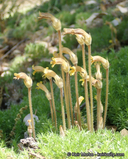Taxon Details
Aphyllon epigalium ssp. notocalifornicum
Southern California galium broomrape
View Report Copy Link Calflora eFlora CCH CalPhotos iNaturalist
Taxon Summary:
Aphyllon epigalium ssp. notocalifornicum, commonly known as Southern California galium broomrape, is a annual/perennial herb (parasitic) in the Orobanchaceae that is found only in California. It occurs within Cismontane woodland, Lower montane coniferous forest, and Riparian forest, growing at elevations from 1200 to 1535 meters. Aphyllon epigalium ssp. notocalifornicum is ranked 1B.3, Plants Rare, Threatened or Endangered in California and Elsewhere; Not very threatened in California.|
Scientific Name: Aphyllon epigalium Colwell & A. C. Schneid. ssp. notocalifornicum Colwell & A. C. Schneid. |
||
|
Common Name: Southern California galium broomrape |
||
| Family: | Orobanchaceae | |
| Element Code: | PDORO05012 | |
| USDA Plants Symbol: | ||
|
Synonyms/Other Names: |
||
| Name Status: |
JEF, FNA, POWO, IPNI, Tropicos |
|
| CA Rare Plant Rank: | 1B.3 |
| Fed List: | None |
| State List: | None |
| Global Rank: | G4T2 |
|
State Rank: |
S2 |
| Other Status: | |
|
CRPR Changes: added to 1B.3 on 2023-09-20 |
|
| Add Date: | 2023-08-09 |
| Date Edited: | 2025-10-29 |
| Lifeform: annual/perennial herb (parasitic) | ||||||||||||||
Blooming Period: Jun(Jul)
|
||||||||||||||
|
Elevation:
1200 - 1535 meters 3935 - 5035 feet |
||||||||||||||
General Habitats:
|
||||||||||||||
| Microhabitat Details: Associated host is Gallium andrewsii and possibly other perennial Galium spp. Most records are from stands of Pseudotsuga macrocarpa. | ||||||||||||||
|
Microhabitat:
|
||||||||||||||
|
Notes: While Colwell et al. (2017) include May in the flowering time, no May records were found. |
|
|
Threats: Potentially threatened by improper burning regime. |
|
|
Taxonomy: Previously identified as either A. fasciculatum or (sometimes) A. purpureum; differentiated by its growth on Galium and the presence of 2-4 yellow flowers per stem with pedicels longer than the stem. Differentiated from A. epigalium ssp. epigalium by its paler, straw-colored flowers and shorter corollas with more prominently arched tubes, +/- horizontal mouths, and narrower lobes with erect or weakly recurved tips. |
|
| Threat List Total: | 0 | |
| Total EOs | % of EOs | |
| EOs with Threat Listed: | 0 | % |
| THREAT LIST: | ||
|---|---|---|
|
|
||
| Total Occurrences: | 8 | ||||
| Element Occurrence Ranks: | |||||
|---|---|---|---|---|---|
| A | B | C | D | X | U |
| 0 | 0 | 0 | 0 | 0 | 8 |
| Occurrence Status: | |||||
|---|---|---|---|---|---|
| Historical >20 Years | 5 | ||||
| Recent <=20 Years | 3 | ||||
| Presence: | |||||
|---|---|---|---|---|---|
| Presumed Extant | 8 | ||||
| Possibly Extirpated | 0 | ||||
| Presumed Extirpated | 0 | ||||
| California Endemic: | |||||||||||||
| California Island: | |||||||||||||
|
States: Name (Code) California (CA) |
|||||||||||||
|
California Counties and Islands: Name (Code) San Bernardino (SBD), San Diego (SDG), Ventura (VEN) |
|||||||||||||
|
Quads: Name (Quad Code) Boucher Hill (3311638), Cuyamaca Peak (3211685), Forest Falls (3411618), Palomar Observatory (3311637), Vail Lake (3311648), White Ledge Peak (3411944), Yucaipa (3411711) |
|||||||||||||
Notes:
|
|||||||||||||
 Presumed Extant
Presumed Extant
Click on quad for name. Hold Shift Key to use mouse scroll wheel



